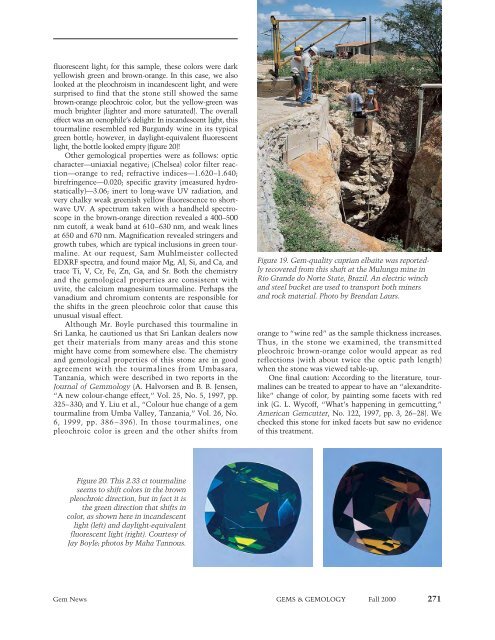Fall 2000 Gems & Gemology - Gemfrance
Fall 2000 Gems & Gemology - Gemfrance
Fall 2000 Gems & Gemology - Gemfrance
Create successful ePaper yourself
Turn your PDF publications into a flip-book with our unique Google optimized e-Paper software.
fluorescent light; for this sample, these colors were dark<br />
yellowish green and brown-orange. In this case, we also<br />
looked at the pleochroism in incandescent light, and were<br />
surprised to find that the stone still showed the same<br />
brown-orange pleochroic color, but the yellow-green was<br />
much brighter (lighter and more saturated). The overall<br />
effect was an oenophile’s delight: In incandescent light, this<br />
tourmaline resembled red Burgundy wine in its typical<br />
green bottle; however, in daylight-equivalent fluorescent<br />
light, the bottle looked empty (figure 20)!<br />
Other gemological properties were as follows: optic<br />
character—uniaxial negative; (Chelsea) color filter reaction—orange<br />
to red; refractive indices—1.620–1.640;<br />
birefringence—0.020; specific gravity (measured hydrostatically)—3.06;<br />
inert to long-wave UV radiation, and<br />
very chalky weak greenish yellow fluorescence to shortwave<br />
UV. A spectrum taken with a handheld spectroscope<br />
in the brown-orange direction revealed a 400–500<br />
nm cutoff, a weak band at 610–630 nm, and weak lines<br />
at 650 and 670 nm. Magnification revealed stringers and<br />
growth tubes, which are typical inclusions in green tourmaline.<br />
At our request, Sam Muhlmeister collected<br />
EDXRF spectra, and found major Mg, Al, Si, and Ca, and<br />
trace Ti, V, Cr, Fe, Zn, Ga, and Sr. Both the chemistry<br />
and the gemological properties are consistent with<br />
uvite, the calcium magnesium tourmaline. Perhaps the<br />
vanadium and chromium contents are responsible for<br />
the shifts in the green pleochroic color that cause this<br />
unusual visual effect.<br />
Although Mr. Boyle purchased this tourmaline in<br />
Sri Lanka, he cautioned us that Sri Lankan dealers now<br />
get their materials from many areas and this stone<br />
might have come from somewhere else. The chemistry<br />
and gemological properties of this stone are in good<br />
agreement with the tourmalines from Umbasara,<br />
Tanzania, which were described in two reports in the<br />
Journal of Gemmology (A. Halvorsen and B. B. Jensen,<br />
“A new colour-change effect,” Vol. 25, No. 5, 1997, pp.<br />
325–330; and Y. Liu et al., “Colour hue change of a gem<br />
tourmaline from Umba Valley, Tanzania,” Vol. 26, No.<br />
6, 1999, pp. 386–396). In those tourmalines, one<br />
pleochroic color is green and the other shifts from<br />
Figure 20. This 2.33 ct tourmaline<br />
seems to shift colors in the brown<br />
pleochroic direction, but in fact it is<br />
the green direction that shifts in<br />
color, as shown here in incandescent<br />
light (left) and daylight-equivalent<br />
fluorescent light (right). Courtesy of<br />
Jay Boyle; photos by Maha Tannous.<br />
Figure 19. Gem-quality cuprian elbaite was reportedly<br />
recovered from this shaft at the Mulungu mine in<br />
Rio Grande do Norte State, Brazil. An electric winch<br />
and steel bucket are used to transport both miners<br />
and rock material. Photo by Brendan Laurs.<br />
orange to “wine red” as the sample thickness increases.<br />
Thus, in the stone we examined, the transmitted<br />
pleochroic brown-orange color would appear as red<br />
reflections (with about twice the optic path length)<br />
when the stone was viewed table-up.<br />
One final caution: According to the literature, tourmalines<br />
can be treated to appear to have an “alexandritelike”<br />
change of color, by painting some facets with red<br />
ink (G. L. Wycoff, “What’s happening in gemcutting,”<br />
American Gemcutter, No. 122, 1997, pp. 3, 26–28). We<br />
checked this stone for inked facets but saw no evidence<br />
of this treatment.<br />
Gem News GEMS & GEMOLOGY <strong>Fall</strong> <strong>2000</strong> 271


